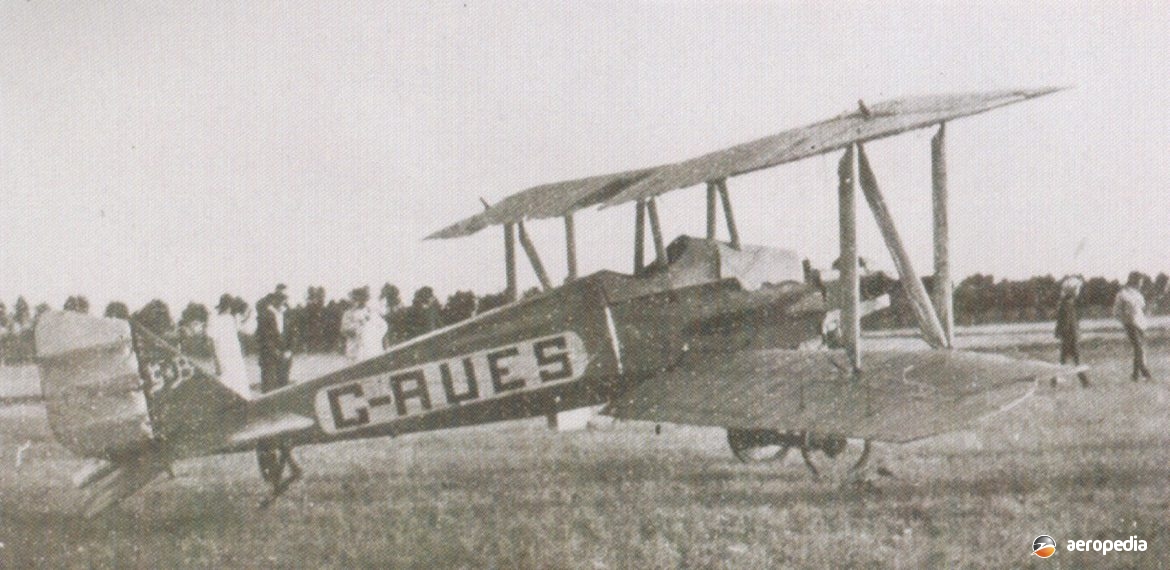Photograph:
Blanch Experimental biplane after construction carrying the registration G-AUES (Keith Meggs collection)
Country of origin:
Australia
Description:
Single-seat light sport biplane
Power Plant:
One 19.3 kw (26 hp) Morehouse two-cylinder horizontally-opposed engine
Specifications:
- Wingspan: 7.92 m (26 ft)
- Length: 6.4 m (21 ft)
- Max speed: 97 km/h (60 mph)
- Initial rate of climb: 61 m/min (200 ft/min)
- Loaded weight: 295 kg (650 lb)
History:
The Blanch Biplane, also known as the Blanch Experimental, was designed and constructed by Mr William James Blanch in the 1920s near Armadale, WA. Mr Blanch was an engineer who migrated to Australia following the conclusion of World War I. His aim was to design and construct a light biplane demonstrating the feasibility of producing an aircraft with a low powered engine which could be constructed cheaply and sold to future aviators. He was interested in aviation and began construction of a single-seat light biplane for which Certificate of Registration 106 and registration G-AUES (c/n 1) were allotted but not taken up. It was of wooden construction with fabric covering and was to be powered by a 19.3 kw (26 hp) Morehouse engine produced by the E B Heath Company of Chicago, USA, this company also building the popular, at the time, Heath Parasol monoplane.
The Australian Civil Aviation Branch (CAB) was approached by Mr Blanch in 1922 to inform them that material for construction had been ordered and he was founding a business to build and develop the aircraft, being backed for the for the construction of the prototype by Messrs Gordon and Clark who operated as Gordon Motor & Cycle Co of Perth, WA. Construction took place in the rear of a soft-drink shop in Third Avenue, Armadale. The CAB was supplied with technical data, calculations and drawings.In July 1922 Captain Frank Barnwell (1880-1938), Chief designer of the Bristol Aeroplane Company, made a structural analysis of the design. Estimated performance included a speed of 97 km/h (60 mph).
CAB inspections were made in January 1923 of the aircraft and the work was said to be highly creditable but detail workmanship was not up to the standard required for a Certificate of Airworthiness. Further CAB inspections in May and September 1923 required major changes to the construction, including the re-design of the wing with the original solid spars replaced by built-up units. At the latter inspections the fuselage, tailplane and elevators were covered and the fuel tank, instruments, controls and engine were installed but work on the wings had not advanced far.
The wings were completed by June 1924 and the CAB inspector stated the workmanship was in advance of anything done up to that time. By January 1925 the uncovered wings were attached to the fuselage and all controls connected. The aircraft was moved to Cullen’s Field off Railway Avenue where taxiing trials were commenced but it was found the engine would not exceed 1,150 rpm and thus not supply sufficient power.
Mr Blanch then applied to the CAB for £3,000 ($6,000) to set up a facility to build the design but this was not forthcoming. He was offered a 21.6 kw (29 hp) Morehouse engine built in the United States by Wright. In the event this engine was not imported and consideration was given to a chain driven converted Henderson motor-cycle engine. Certificate of Registration No 106 was then allotted. Further modifications to the aircraft were made, including installation of a new carburettor and strengthening of the undercarriage.
Soon after, financial support for the aircraft was withdrawn by the backers and the aircraft was left under a tree on Sherwood Estate. The wings were removed and placed in the loft of a barn but the fuselage suffered some damage from vermin and had to be moved to a shed at Maddington. It seems the aircraft was complete and ready for flight but was never flown.
The Civil Aviation Branch suggested an ABC Scorpion engine be procured to be installed at its cost, which could later be used in the Branch’s de Havilland DH.53s but this did not occur. The aircraft was still in existence during World War II but its final fate is not known. Mr Blanch died in about 1929.

